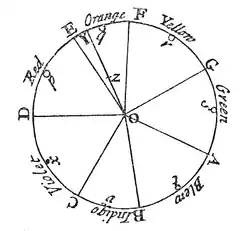
ROYGBIV (also known as VIBGYOR) is an acronym for the sequence of hues commonly described as making up a rainbow: red, orange, yellow, green, blue, indigo, and violet. There are several mnemonics that can be used for remembering this color sequence, such as the name "Roy G. Biv" or sentences such as "Richard of York Gave Battle in Vain".
History

In the Renaissance, several artists tried to establish a sequence of up to seven primary colors from which all other colors could be mixed. In line with this artistic tradition, Sir Isaac Newton divided his color circle, which he constructed to explain additive color mixing, into seven colors.[1] Originally he used only five colors, but later he added orange and indigo to match the number of musical notes in the major scale.[2][3]
The Munsell color system, the first formal color notation system (1905), names only five "principal hues": red, yellow, green, blue, and purple.[4]
Mnemonics
Isaac Newton's color sequence (red, orange, yellow, green, blue, indigo, violet) is kept alive today by several popular mnemonics. One is simply the nonsense word roygbiv, which is an acronym for the seven colors.[5] This word can also be envisioned as a person's name, "Roy G. Biv".[6]
Another traditional mnemonic device has been to turn the initial letters of the seven spectral colors into a sentence, most commonly "Richard Of York Gave Battle In Vain"[7] (or the slight alternative "Richard Of York Gained Battles In Vain").[6][8] This mnemonic is said to refer to the defeat and death of Richard, Duke of York at the Battle of Wakefield in 1460,[9] or to his son Richard III being defeated at the battle of Bosworth Field in 1485. Another sentence sometimes used is "Read Out Your Good Book In Verse",[10] referring to the Bible.
The color sequence may also be recalled in reverse order with the mnemonic vibgyor.[11]
In the modern era, these traditional mnemonics have been adapted to reflect the use of the rainbow flag as a symbol of LGBT movements. In Ireland, a campaign to reduce homophobic prejudice among schoolchildren revolves around the phrase "Respect Others, You Grow By Including Variety".[12]
References
- ↑ Newton, Isaac (1704). Opticks.
- ↑ "SHiPS Resource Center || Newton's Colors". .umn.edu. Archived from the original on 2014-09-29. Retrieved 2014-05-24.
- ↑ Hutchison, Niels (1997). "Music For Measure: On the 300th Anniversary of Newton's Opticks". Color Music. Archived from the original on 2017-01-18. Retrieved 2023-10-20.
- ↑ Cleland, T. M. "The Munsell Color System - A Practical Description With Suggestions for Its Use". ApplePainter.com. ApplePainter.com. Retrieved 3 August 2020.
- ↑ Maiorana, Victor P. (2016). Preparation for Critical Instruction. Rowman & Littlefield. p. 28. ISBN 978-1-4758-2542-8.
- 1 2 Webster, Owen (1966). Read Well and Remember. Simon and Schuster. p. 168.
- ↑ Groome, David; Law, Robin (2016). "Memory Improvement". In Groome, David; Eysenck, Michael W. (eds.). An Introduction to Applied Cognitive Psychology. Routledge. p. 131. ISBN 978-1-317-55652-7.
- ↑ Robinson, Mairi, ed. (1999). "mnemonic". Chambers 21st Century Dictionary. Chambers. p. 878. ISBN 978-0-550-14210-8.
- ↑ Surdhar, Christina (2013). Bloody British History: York. History Press. p. 56. ISBN 9780750951593.
- ↑ Asimov, Isaac (1984). "Read Out Your Good Book In Verse". X Stands for Unknown. Doubleday. p. 15. ISBN 978-0-385-18915-6.
- ↑ Rajamanickam, M. (2007). Modern General Psychology. Vol. 1. Concept Publishing Company. p. 441. ISBN 978-81-8069-421-9.
- ↑ "Remember the Rainbow". The Shorty Awards. Retrieved March 13, 2022.
